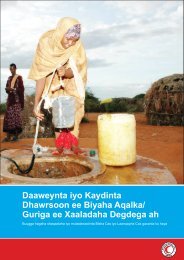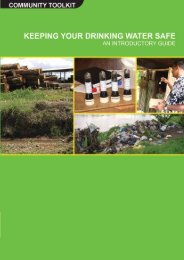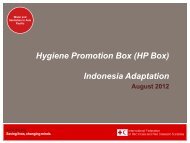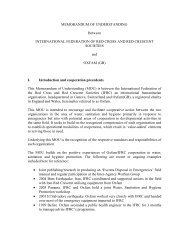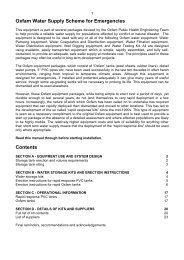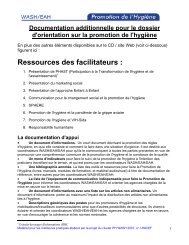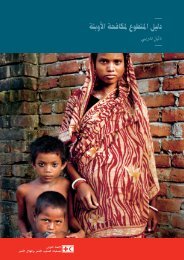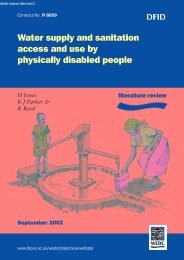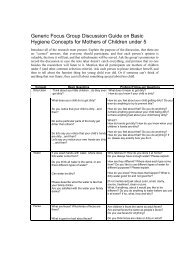Appendix 3. Definitions"Health education is the process of interaction between people in order to discuss theirhealth situation, with the aim to create awareness about health status <strong>and</strong> to decide jointlyhow this situation can be improved” (Timmermans <strong>and</strong> de Walle, 1995: 278)“<strong>Hygiene</strong> education is ..all activities aimed at encouraging behaviour which will help toprevent water <strong>and</strong> sanitation- related diseases” (Boot <strong>and</strong> Cairncross, 1993: 33)“<strong>Hygiene</strong> promotion is the planned approach to preventing diarrhoeal <strong>and</strong> other water <strong>and</strong>sanitation related diseases through the widespread adoption of safe hygiene practices”(Adjusted from Curtis <strong>and</strong> Kanki, 1998: 10)These are some of the more recent definitions on the promotion of better health <strong>and</strong>hygiene. In these definitions, health refers to what the World Health Organizes defines as‘a state of complete physical, mental, <strong>and</strong> social well-being <strong>and</strong> not merely the absence ofdisease, or infirmity’.(online available http://www.who.int/hpr/ageing/Men Ageing <strong>and</strong>Health.doc). <strong>Hygiene</strong> comes from the Greek hygieinos, which translates literally as‘healthful’. The term has, however, come to mean “the practice of keeping oneself <strong>and</strong>one’s surroundings clean, especially to prevent illness or the spread of diseases” (Boot<strong>and</strong> Cairncross, 1993: 6).While health education <strong>and</strong> promotion thus st<strong>and</strong> for the encouragement, in many differentways, of a better overall well-being, hygiene education <strong>and</strong> promotion relate especially toreduction of infectious diseases spread through unhygienic conditions <strong>and</strong> practices.Infectious diseases are the world’s leading cause of death.http://www.un.org/Pubs/CyberSchoolBus/special/health/index.htmlIn 1997, at least 17.3 million, ore one third of 52.2 million women, children <strong>and</strong> men diedfrom these diseases. Among them, diseases related to poor hygiene, sanitation <strong>and</strong> watersupply, are highly prevalent, especially diarrhoeas. Table 1 gives information on how muchthese incidences can be reduced by improving sanitation, hygiene, <strong>and</strong> the use of more<strong>and</strong> safer water.In the above definitions, the terms hygiene “education” <strong>and</strong> “promotion” are both used foractivities <strong>and</strong> programmes that encourage better hygiene. In this paper, we givepreference to the term hygiene promotion because hygiene education is often still used inits narrow meaning of spreading information <strong>and</strong> giving instructions. On their own, theseactivities are seldom suitable to bring about lastingly improved conditions <strong>and</strong> practices.76 <strong>Hygiene</strong> promotion
Appendix 4. WASH facts <strong>and</strong> figures1. billion people in the world do not have access to safe water, roughly one-sixth of theworld’s population.2. 2.4 billion people in the world do not have access to adequate sanitation, about twofifthsof the world’s population.3. 2.2 million people in developing countries, most of them children, die every year fromdiseases associated with lack of access to safe drinking water, inadequate sanitation<strong>and</strong> poor hygiene.4. Some 6,000 children die every day from diseases associated with lack of access tosafe drinking water, inadequate sanitation <strong>and</strong> poor hygiene – equivalent to 20 jumbojets crashing every day.5. At any one time it is estimated that half of the world’s hospital beds are occupied bypatients suffering from water-borne diseases.6. 200 million people in the world are infected with schistosomiasis, of whom 20 millionsuffer severe consequences. The disease is still found in 74 countries of the world.Scientific studies show that a 77% reduction of incidence from the disease wasachieved through well-designed water <strong>and</strong> sanitation interventions.7. The average distance that women in Africa <strong>and</strong> Asia walk to collect water is 6 km.8. The weight of water that women in Africa <strong>and</strong> Asia carry on their heads is theequivalent of your airport luggage allowance (20kg).9. The average person in the developing world uses 10 litres of water a day.10. The average person in the United Kingdom uses 135 litres of water every day.11. One flush of your toilet uses as much water as the average person in the developingworld uses for a whole day’s washing, cleaning, cooking <strong>and</strong> drinking.12. Comparative costs: In Europe $11 billion is spent each year on ice cream; in USA<strong>and</strong> Europe, $17 billion is spent on pet food; in Europe $105 billion is spent annuallyon alcoholic drinks, ten times the amount required to ensure water, sanitation <strong>and</strong>hygiene for all.13. In the past 10 years diarrhoea has killed more children than all the people lost toarmed conflict since World War II.14. In China, India <strong>and</strong> Indonesia twice as many people are dying from diarrhoealdiseases as from HIV/AIDS.15. In 1998, 308,000 people died from war in Africa, but more than two million (six timesas many) died of diarrhoeal disease.16. The population of the Kibeira slum in Nairobi, Kenya pay up to five times the price fora litre of water than the average American citizen.17. An estimated 25% of people in developing country cities use water vendorspurchasing their water at significantly higher prices than piped water.18. Projections for 2025 indicate that the number of people living in water-stressedcountries will increase to 3 billion – a six-fold increase. Today, 470 million people livein regions where severe shortages exist.19. The simple act of washing h<strong>and</strong>s with soap <strong>and</strong> water can reduce diarrhoeal diseaseby one-third.<strong>IRC</strong> <strong>International</strong> <strong>Water</strong> <strong>and</strong> <strong>Sanitation</strong> <strong>Centre</strong> 77
- Page 2:
Please note that the TOPs are a web
- Page 7 and 8:
1. Hygiene PromotionWhat do you kno
- Page 9 and 10:
2. Why hygiene promotion matters2.1
- Page 11 and 12:
• The costs of inaction can be hi
- Page 13 and 14:
3. Learning from experiences and re
- Page 15 and 16:
• Hygiene Improvement Framework (
- Page 17 and 18:
groups, and facilitators of partici
- Page 19 and 20:
The diagrams are taken from McKee
- Page 21 and 22:
• Food, utensils and food prepara
- Page 23 and 24:
Guides for developing hygiene promo
- Page 25 and 26:
• What may prevent this change in
- Page 27 and 28: areas, slabs and sanplats for latri
- Page 29 and 30: often not taken seriously and their
- Page 31 and 32: IIIIIIIVVInputsProcOutpEffectiImpae
- Page 33 and 34: over for reasons of hierarchy, e.g.
- Page 35 and 36: 5. Case studiesOn the following pag
- Page 37 and 38: The Project recognises the importan
- Page 39 and 40: almost all cases been exceeded, as
- Page 41 and 42: skin diseases, HIV/AIDS and tubercu
- Page 43 and 44: understanding of the importance of
- Page 45 and 46: councils (JSCs) are associations of
- Page 47 and 48: o through a schools programme, with
- Page 49 and 50: outputs and outcomes are focused mo
- Page 51 and 52: Harvey, Eric, Shadrack Dau, Alana P
- Page 53 and 54: programmes more effective. The obje
- Page 55 and 56: scale. Comparison is on approach, l
- Page 57 and 58: Hygiene Behaviour Network, in Globa
- Page 59 and 60: WHO - World Health Organizationhttp
- Page 61 and 62: Tel: (703) 247-8730Fax: (703) 243-9
- Page 63 and 64: Manila, PhilippinesTel: +632 911-57
- Page 65 and 66: TOP Courses and conferencesCREPA, B
- Page 67 and 68: TOP ReferencesBoot, Marieke T. and
- Page 69 and 70: TOP Quiz on Hygiene PromotionTry it
- Page 71 and 72: Question 4All the interventions wil
- Page 73 and 74: Then you may decide that this paper
- Page 75 and 76: Appendix 1. Hygiene promotion manua
- Page 77: 2. Target specific audiences.These
- Page 81 and 82: Research)18: (IHE Newsletter, Janua
- Page 83 and 84: Appendix 6. Preventive measuresMeas
- Page 85 and 86: Appendix 8. Some key objectives for
- Page 87 and 88: Appendix 9. Participatory tools and
- Page 89 and 90: Appendix 10. The PHAST approachFor
- Page 91 and 92: Planning techniques are used to sim
- Page 93 and 94: While sensitive topics are often be
- Page 95: About IRCIRC facilitates the sharin



